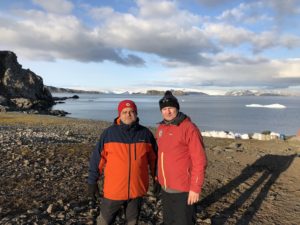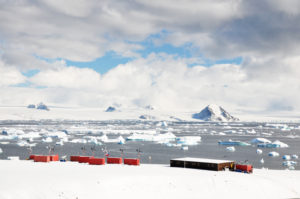We have already came across the Huts at the Sub-Antarctic Macquarie Island (WAP AUS-Ø8), on last april 2019, see: http://www.waponline.it/a-quick-tour-among-the-huts-at-macquarie-island/.
Today we’ll have a brief tour through the historical Huts on the same island:
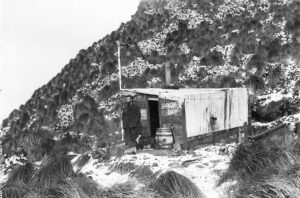 Historic Old Sandy Bay Hut Everyone on the island, and all the tourists who visit, are familiar with the little old field hut at Sandy Bay. It is solid as a rock and banded with rusty iron, tussocks grow on top and roosting skuas keep watch over the surrounding king penguin colony. It is a picturesque sight.
Historic Old Sandy Bay Hut Everyone on the island, and all the tourists who visit, are familiar with the little old field hut at Sandy Bay. It is solid as a rock and banded with rusty iron, tussocks grow on top and roosting skuas keep watch over the surrounding king penguin colony. It is a picturesque sight.
The door bolt is rusted shut, but expeditioners can peer in the grubby window at a dark, decrepit interior festooned with penguin-moult feathers caught up in spider webs – very atmospheric. Feathers from moulting penguins can be found everywhere, as we know from doing our weekly communal clean-up duties. It is amazing how they can sneak through the tiniest crevices in buildings.
Historic Old Lusitana Bay Hut
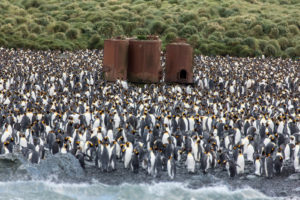 The little old Hut at Lusitania Bay (54° 42′ South, 154°50′ East) just north of the king penguin colony. The huts are old Walrus aircraft engine packing crates, put in place in 1949. They served as field huts for many years and still could have, no doubt, except that the king penguin colonies at Sandy Bay and Lusitania Bay overtook them both and they were abandoned in favour of the new huts at Brothers Point and Waterfall Bay. (pic aside show Lusitania Bay’s penguin colony)
The little old Hut at Lusitania Bay (54° 42′ South, 154°50′ East) just north of the king penguin colony. The huts are old Walrus aircraft engine packing crates, put in place in 1949. They served as field huts for many years and still could have, no doubt, except that the king penguin colonies at Sandy Bay and Lusitania Bay overtook them both and they were abandoned in favour of the new huts at Brothers Point and Waterfall Bay. (pic aside show Lusitania Bay’s penguin colony)
Other Huts at Macquarie Island
Huts and try works were located at the Isthmus, Sandy Bay, Lusitania Bay, Caroline Cove and Hurd Point. Russian explorer Thaddeus Bellingshausen visited Macquarie Island in 1820 and reported that a total of 40 men were working on the island. He also left an interesting description of the sealers hut at Sandy Bay which was:
20 feet long by 10 feet broad, inside it was lined with skins of seals, the outside was covered with a kind of grass which grows on the island. At one end was a small hearth, and a lamp was always kept alight. … Beside the hearth was a bedstead. Provisions were stored at the other end of the hut. Inside it was so black and dark from the smoke that the smouldering light from the lamp and from the holes in the wall over which bladders were stretched, scarcely lit the interior of the hut, and until we got accustomed to the light the sealers had to lead us by the hand.
Let’s have a look to the others removed Huts:
With the long awaited recognition that Macquarie Island was cat free this last season, there was no longer any justification for the presence of the three plateau Field Huts that had been established some years ago to provide accommodation for the Tasmanian Parks and Wildlife staff involved in the cat eradication project, part of the Vertebrate Pest Management Program:
They were:
Mt Eitel Hut (54° 36.6′ South, 158° 50.9′ East),
Lake Tiobunga Hut (54° 41.7′ South, 158° 49.2′ East)
Windy Ridge Hut (54° 44.0′ South, 158° 49.8′ East).
Another Hut was established at Davis Point in 1993 for the purpose of conducting the marine debris survey.
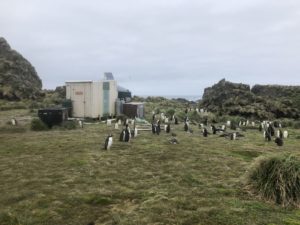 Davis Point Hut (54° 39.9′ South, 158° 49.5′ East) There is a small hut at Davis Point (pic aside) used for special fieldwork and as a refuge, which catches rain water off the roof. Davis Point hut is a cross country transit to Green Gorge Hut
Davis Point Hut (54° 39.9′ South, 158° 49.5′ East) There is a small hut at Davis Point (pic aside) used for special fieldwork and as a refuge, which catches rain water off the roof. Davis Point hut is a cross country transit to Green Gorge Hut
The Davis Point Hut is one of seven shelters dropped across the island for hunters and their dogs tracking rabbits. They were a vital part of the Macquarie Island eradication of pests.
As this work will now be centered on Bauer Bay, there was no longer any need for this hut to remain on the island. Mt Eitel apple hut packed up. Rat-proof cage pallet in foreground. March 2003
When the ship arrived at the end of March, the helicopters were deployed to lift both the Davis Point Hut and the three apple huts from the plateau, by cable sling and transport them back to the main station area. Each hut was accompanied by two pre-packed cage pallets, gas bottles and a black rat-proof cage pallet with perishable items such as food. It took about three to four hours of work to totally remove each of the apple huts and their contents.
All four huts were then transported by helicopter from the Isthmus to the ship ready for return to Australia.
Source: http://www.antarctica.gov.au/about-antarctica/history/exploration-and-expeditions/modern-expeditions/this-week-in-antarctica/2003/macquarie-island2/out-they-come-macquarie-is-field-hut-removal
REFUGES (HUTS)
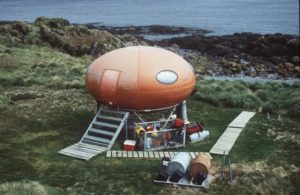 Brothers Point 54° 34.4′ South, 158° 55.1′ East (pic on the right show the Googie Hut at Brother’s point)
Brothers Point 54° 34.4′ South, 158° 55.1′ East (pic on the right show the Googie Hut at Brother’s point)
Davis Point 54° 39.9′ South, 158° 49.5′ East
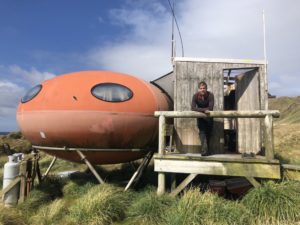 Waterfall Bay Hut (pic on the left) located at 54° 41.5′ South, 158° 51.9′ East
Waterfall Bay Hut (pic on the left) located at 54° 41.5′ South, 158° 51.9′ East
Tiobunga 54° 41.7′ South, 158° 49.2′ E
Windy Ridge 54° 44.0′ South, 158° 49.8′ East
Caroline Cove 54° 45.8′ South, 158° 47.5′ East
Thanks and credit to the following web sites:
http://www.antarctica.gov.au/about-antarctica/history/stations/macquarie-island
http://www.antarctica.gov.au/living-and-working/stations/macquarie-island/this-week-at-macquarie-island/2016/this-week-at-macquarie-island-16-december-2016
http://bazintaz.blogspot.com/2013/11/seven-days-on-island-part-3.html
http://macquarieislandisland.blogspot.com/
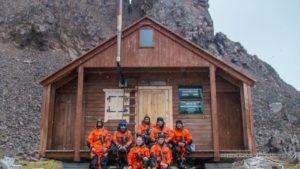 Located on ASPA 128, Demay refuge (wood hut) 62°13’ South, 58°26’30” West, is situated on a flat marine gravel terrace in Paradise Cove between Demay Point and Uchatka Point. The refuge can be reached both by Zodiac and by foot.
Located on ASPA 128, Demay refuge (wood hut) 62°13’ South, 58°26’30” West, is situated on a flat marine gravel terrace in Paradise Cove between Demay Point and Uchatka Point. The refuge can be reached both by Zodiac and by foot.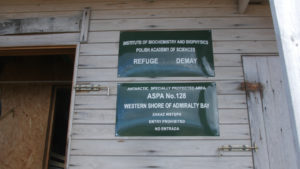 Their memories are preserved in the cottage guest book. The refuge contains two bunk beds, gas cooker, stove and even a shower. There is a VHF radio available with antenna on the rocks above the refuge. It is perfect for hiding from the cold, wind, blizzard and heavy rain. Those who stayed in the Paradise overnight can confirm that few earthy pleasures compare to a dawn on the veranda with a warm cup of tea in hands and a view over a calm horizon decorated with icebergs, waves breaking against the rocks of Demay Head, sleepy elephant seals and playful furseals.
Their memories are preserved in the cottage guest book. The refuge contains two bunk beds, gas cooker, stove and even a shower. There is a VHF radio available with antenna on the rocks above the refuge. It is perfect for hiding from the cold, wind, blizzard and heavy rain. Those who stayed in the Paradise overnight can confirm that few earthy pleasures compare to a dawn on the veranda with a warm cup of tea in hands and a view over a calm horizon decorated with icebergs, waves breaking against the rocks of Demay Head, sleepy elephant seals and playful furseals.

 The little old Hut at Lusitania Bay (54° 42′ South, 154°50′ East) just north of the king penguin colony. The huts are old Walrus aircraft engine packing crates, put in place in 1949. They served as field huts for many years and still could have, no doubt, except that the king penguin colonies at Sandy Bay and Lusitania Bay overtook them both and they were abandoned in favour of the new huts at Brothers Point and Waterfall Bay. (pic aside show Lusitania Bay’s penguin colony)
The little old Hut at Lusitania Bay (54° 42′ South, 154°50′ East) just north of the king penguin colony. The huts are old Walrus aircraft engine packing crates, put in place in 1949. They served as field huts for many years and still could have, no doubt, except that the king penguin colonies at Sandy Bay and Lusitania Bay overtook them both and they were abandoned in favour of the new huts at Brothers Point and Waterfall Bay. (pic aside show Lusitania Bay’s penguin colony)
 Brothers Point 54° 34.4′ South, 158° 55.1′ East (pic on the right show the Googie Hut at Brother’s point)
Brothers Point 54° 34.4′ South, 158° 55.1′ East (pic on the right show the Googie Hut at Brother’s point) Waterfall Bay Hut (pic on the left) located at 54° 41.5′ South, 158° 51.9′ East
Waterfall Bay Hut (pic on the left) located at 54° 41.5′ South, 158° 51.9′ East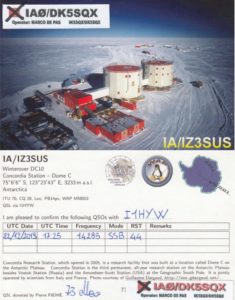 While talking of his Antarctic experience, Marco De Pas (DK5SQX-IK5SQX) is happy for such a great professional and human experience lived in the Icy Continent. -Our LIDAR a kind of optical radar that does “Cloud ranging” works perfectly and that’s great- Marco said!
While talking of his Antarctic experience, Marco De Pas (DK5SQX-IK5SQX) is happy for such a great professional and human experience lived in the Icy Continent. -Our LIDAR a kind of optical radar that does “Cloud ranging” works perfectly and that’s great- Marco said! Thanks to François F8DVD, we can show today an envelope with a rare Chapel of the Snow “cachet” from McMurdo Station (WAP USA-22)
Thanks to François F8DVD, we can show today an envelope with a rare Chapel of the Snow “cachet” from McMurdo Station (WAP USA-22)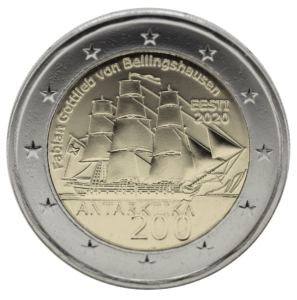 To commemorate this significant historical moment, Eesti Pank is issuing 750,000 two-euro circulation coins with a special Antarctica 200 design, of which 10,000 will be BU (brilliant uncirculated) quality and packaged as collector items on a coin card.
To commemorate this significant historical moment, Eesti Pank is issuing 750,000 two-euro circulation coins with a special Antarctica 200 design, of which 10,000 will be BU (brilliant uncirculated) quality and packaged as collector items on a coin card.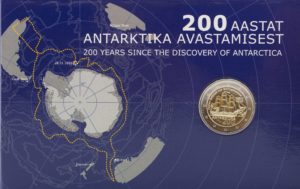 The coins are all legal tender throughout the euro area, so they can be used for payments like any other euro coin.
The coins are all legal tender throughout the euro area, so they can be used for payments like any other euro coin.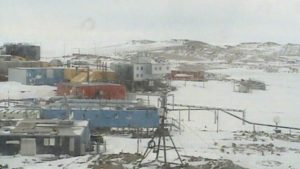 The 61st JARE (Japanese Antarctic Research Expedition) is on: It has started last February 2020 and will last till January 2021,
The 61st JARE (Japanese Antarctic Research Expedition) is on: It has started last February 2020 and will last till January 2021,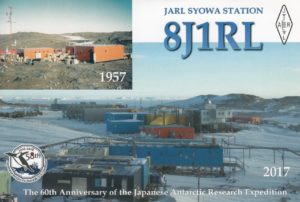
 “Italia Valley” Antarctic Memorial (MAVI) Cepparo-Bove, celebrates the day without forgetting its goal: a formal designation of a new HSM for the remaining ruins of the first Italian scientific research base in Antarctica, destroyed by the Argentine Navy, and abandoned for over 40 years. Ruins are still visible at Italia Valley.
“Italia Valley” Antarctic Memorial (MAVI) Cepparo-Bove, celebrates the day without forgetting its goal: a formal designation of a new HSM for the remaining ruins of the first Italian scientific research base in Antarctica, destroyed by the Argentine Navy, and abandoned for over 40 years. Ruins are still visible at Italia Valley.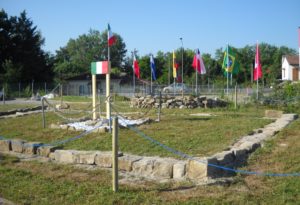 A replica of the actual ruins, has been rebuilt at Cervignano del Friuli (Udine) by students, Civil Protection and many associations at high school “IISS Arturo Malignani” in Northern Italy. It is called ex situ conservation, and describes the reconstruction of that old Antarctic site. A preliminary step for a future formal designation of a new HSM (Historic Site and Monument) within the ATCM (Antarctic Treaty Consultative Meeting).
A replica of the actual ruins, has been rebuilt at Cervignano del Friuli (Udine) by students, Civil Protection and many associations at high school “IISS Arturo Malignani” in Northern Italy. It is called ex situ conservation, and describes the reconstruction of that old Antarctic site. A preliminary step for a future formal designation of a new HSM (Historic Site and Monument) within the ATCM (Antarctic Treaty Consultative Meeting).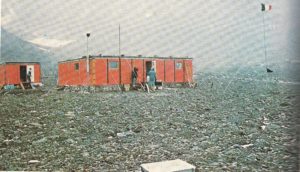 The activity aims to recover the historical memory of the Italia Valley in the Antarctic Peninsula, a strategic and naturalistic place where, in 1976, Renato Cepparo founded the first Italian Scientific Base in Antarctica (pic aside), which he named after the nineteenth-century explorer Giacomo Bove, brave officer of the Italian Royal Navy.
The activity aims to recover the historical memory of the Italia Valley in the Antarctic Peninsula, a strategic and naturalistic place where, in 1976, Renato Cepparo founded the first Italian Scientific Base in Antarctica (pic aside), which he named after the nineteenth-century explorer Giacomo Bove, brave officer of the Italian Royal Navy. ICOMOS works for the conservation and protection of cultural heritage places. It is the only global non-government organization of this kind, which is dedicated to promoting the application of theory, methodology, and scientific techniques to the conservation of the architectural and archaeological heritage.
ICOMOS works for the conservation and protection of cultural heritage places. It is the only global non-government organization of this kind, which is dedicated to promoting the application of theory, methodology, and scientific techniques to the conservation of the architectural and archaeological heritage. For more than 116 years, men and women (civilians and military) have been working in and for Argentina’s Antarctica, revealing the secrets of this frozen and mysterious land, carrying out important national and international scientific missions.
For more than 116 years, men and women (civilians and military) have been working in and for Argentina’s Antarctica, revealing the secrets of this frozen and mysterious land, carrying out important national and international scientific missions.
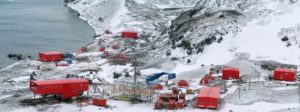 Although there have been no confirmed Covid-19 cases in Earth’s southernmost continent, the disease has nonetheless taken its toll on those there. Just ask the researchers and members of the military who recently experienced major difficulties in making it back home from the two Spanish bases in Antarctica.
Although there have been no confirmed Covid-19 cases in Earth’s southernmost continent, the disease has nonetheless taken its toll on those there. Just ask the researchers and members of the military who recently experienced major difficulties in making it back home from the two Spanish bases in Antarctica.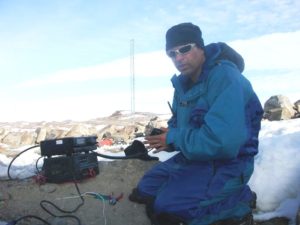 Bhagwati Prasad ,VU3BPZ is an Antarctic veteran. Several times in Antarctica, active from the Indian Base of Maitri (WAP IND-Ø3), Bharati Station (WAP IND-Ø4) and Indian Bay Camp (WAP IND-Ø2). See:
Bhagwati Prasad ,VU3BPZ is an Antarctic veteran. Several times in Antarctica, active from the Indian Base of Maitri (WAP IND-Ø3), Bharati Station (WAP IND-Ø4) and Indian Bay Camp (WAP IND-Ø2). See: 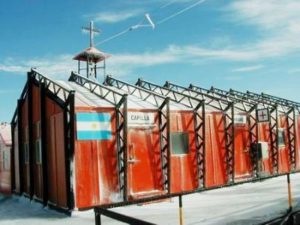 On April 16, 1996, a solemn ceremony was held at Marambio Base (WAP ARG-21), where the Military (Castrense) Bishop of the Argentine Republic in Solemn Pontifical, proceeded to bless and inaugurate the Oratory of the Base, placed under the dedication of the Blessed Virgin of Luján
On April 16, 1996, a solemn ceremony was held at Marambio Base (WAP ARG-21), where the Military (Castrense) Bishop of the Argentine Republic in Solemn Pontifical, proceeded to bless and inaugurate the Oratory of the Base, placed under the dedication of the Blessed Virgin of Luján
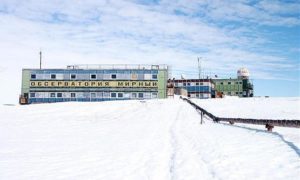 Alexander Solodov, RX3ABI arrived at Mirny Base (WAP RUS-Ø7) on last mid March and has just started to be on air signing RI1ANM.
Alexander Solodov, RX3ABI arrived at Mirny Base (WAP RUS-Ø7) on last mid March and has just started to be on air signing RI1ANM. The Australian Antarctic Division will use the MPV Everest to resupply its Antarctic stations and sub-Antarctic Macquarie Island next summer.
The Australian Antarctic Division will use the MPV Everest to resupply its Antarctic stations and sub-Antarctic Macquarie Island next summer.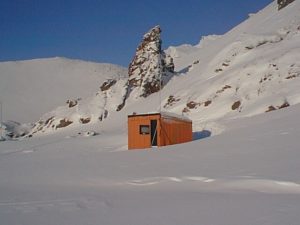 Located at 68° 07’53” South, 67°10’16” West, “Refuge 17 de Agosto” is an Antarctic refuge located in the north east of the Millerand Island in the Marguerite Bay, on Fallières Coast.
Located at 68° 07’53” South, 67°10’16” West, “Refuge 17 de Agosto” is an Antarctic refuge located in the north east of the Millerand Island in the Marguerite Bay, on Fallières Coast.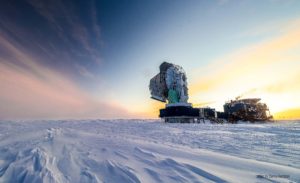 The sun, won’t rise again until September.
The sun, won’t rise again until September.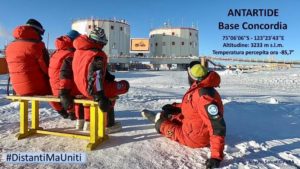
 Beyond all names that are attributed to it, Point Wild on Elephant Island, hosts the bust of Luis Antonio Pardo Villalòn, the Chilean Navy Officer who, in August 30th 1916, commanded the steam Tug Yelcho to rescue the 22 stranded crewmen of Sir Ernast Shackleton’s expedition who survived the wreck of the ship Endurance living for four and one half months in this island.
Beyond all names that are attributed to it, Point Wild on Elephant Island, hosts the bust of Luis Antonio Pardo Villalòn, the Chilean Navy Officer who, in August 30th 1916, commanded the steam Tug Yelcho to rescue the 22 stranded crewmen of Sir Ernast Shackleton’s expedition who survived the wreck of the ship Endurance living for four and one half months in this island.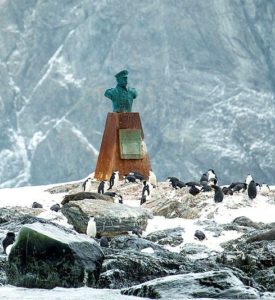 seaweed untill they were finally rescued by Shackleton aboard the Chilean ship Yelcho.
seaweed untill they were finally rescued by Shackleton aboard the Chilean ship Yelcho.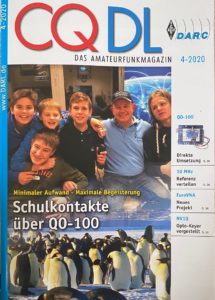 On the April 2020 issue, the German CQ-DL Magazine dedicates several pages to report the QO-100 activity with particular regards to the contact made from Neumayer III Station (WAP DEU-Ø8) and the students at school.
On the April 2020 issue, the German CQ-DL Magazine dedicates several pages to report the QO-100 activity with particular regards to the contact made from Neumayer III Station (WAP DEU-Ø8) and the students at school.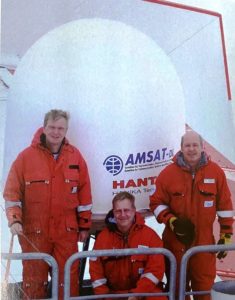
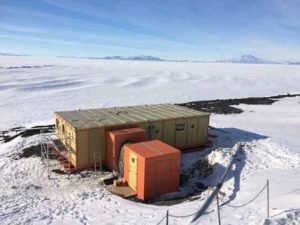 save Sir Ed’s hut in Antarctica is now largely complete
save Sir Ed’s hut in Antarctica is now largely complete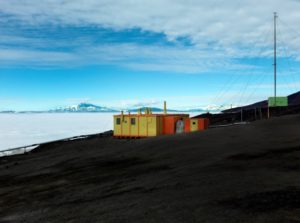 The “A” Hut has been designated a Historic Site or Monument (HSM 75), following a proposal by New Zealand to the Antarctic Treaty Consultative Meeting.
The “A” Hut has been designated a Historic Site or Monument (HSM 75), following a proposal by New Zealand to the Antarctic Treaty Consultative Meeting. For several weeks, scientists working at Vernadsky in Antarctica have been surrounded by what they call “raspberry snow”. Images released by Ukraine’s Ministry of Education and Science on Monday showed the phenomenon, which is caused by microscope snow algae when weather conditions are favorable during Antarctica’s summer months.
For several weeks, scientists working at Vernadsky in Antarctica have been surrounded by what they call “raspberry snow”. Images released by Ukraine’s Ministry of Education and Science on Monday showed the phenomenon, which is caused by microscope snow algae when weather conditions are favorable during Antarctica’s summer months.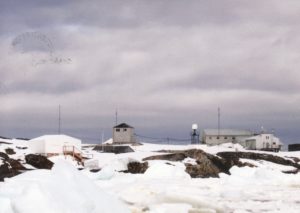

 XR8RRC/p – WAP CHL-13
XR8RRC/p – WAP CHL-13 Antarctica’s bicentenary year, a right time to join UKAHT, a site that keeps the Antarctic enthusiast up to date with lots of exciting work in Antarctica and beyond.
Antarctica’s bicentenary year, a right time to join UKAHT, a site that keeps the Antarctic enthusiast up to date with lots of exciting work in Antarctica and beyond.
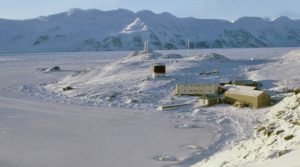
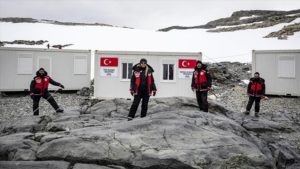 Turkish scientists continue their scientific research on Horseshoe Island in Antarctica. After the construction of Turkey’s first temporary science Base on the island (67°49’40” South, 67°12’08” West), the Team welcomed a group of guests from Chile, Bulgaria, the Czech Republic and Ukraine for the first time. The six guest scientists did work together with the 24-member of the Turkish research Team joins 15 scientific projects in the Earth, life, and marine sciences.
Turkish scientists continue their scientific research on Horseshoe Island in Antarctica. After the construction of Turkey’s first temporary science Base on the island (67°49’40” South, 67°12’08” West), the Team welcomed a group of guests from Chile, Bulgaria, the Czech Republic and Ukraine for the first time. The six guest scientists did work together with the 24-member of the Turkish research Team joins 15 scientific projects in the Earth, life, and marine sciences.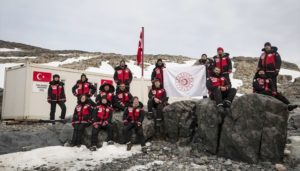 “The GNSS satellite navigation base station was set up within the framework of the fourth Turkish scientific expedition to Antarctica” said Turkish Industry and Technology Minister Mustafa Varank, as quoted by the national Anadolu news agency. “A group of specialists from the Turkish General Directorate of Mapping has built Turkey’s first GNSS base station abroad.”
“The GNSS satellite navigation base station was set up within the framework of the fourth Turkish scientific expedition to Antarctica” said Turkish Industry and Technology Minister Mustafa Varank, as quoted by the national Anadolu news agency. “A group of specialists from the Turkish General Directorate of Mapping has built Turkey’s first GNSS base station abroad.”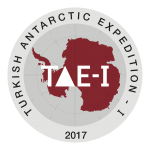 (1 nmi) long and 60 metres (200 ft) high, which is mainly ice covered and is the largest of the Faure Islands, an archipelago lying in Marguerite Bay off the west coast of Graham Land.
(1 nmi) long and 60 metres (200 ft) high, which is mainly ice covered and is the largest of the Faure Islands, an archipelago lying in Marguerite Bay off the west coast of Graham Land.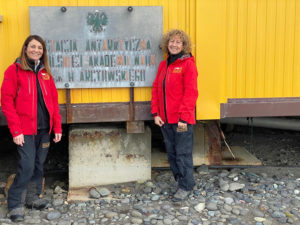 Prof. Carla Caruso and Dr. Laura Bertini (pic aside) of the Department of Ecological and Biological Sciences of the University of Tuscia in Viterbo (Italy) will be back home next march 15th after a month-long mission in Antarctica.
Prof. Carla Caruso and Dr. Laura Bertini (pic aside) of the Department of Ecological and Biological Sciences of the University of Tuscia in Viterbo (Italy) will be back home next march 15th after a month-long mission in Antarctica.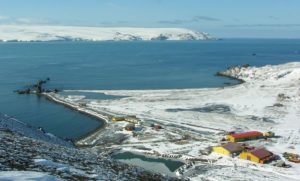
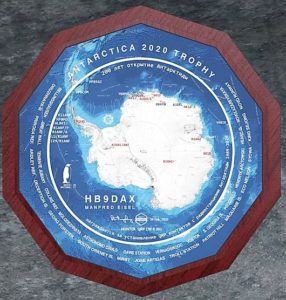
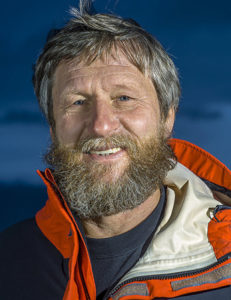 «Antarctica can serve as a model for all humanity today. It’s a Continent without national borders. It is governed by the Antarctic Treaty, which has been in existence for 60 years. This is a superb document, which gives Antarctica to the scientists, not to the military»
«Antarctica can serve as a model for all humanity today. It’s a Continent without national borders. It is governed by the Antarctic Treaty, which has been in existence for 60 years. This is a superb document, which gives Antarctica to the scientists, not to the military»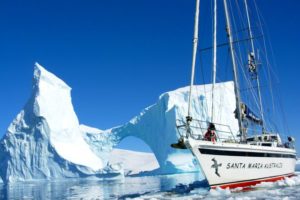 S/Y Santa Maria Australis (aka S/V SMA) is a 66 foot aluminium ketch built in Gdansk, Poland in 1998 and refitted in 2004 to endure high latitude sailing conditions, can accommodate up to a total of 12 people, frequently travelling on the Antarctic waters
S/Y Santa Maria Australis (aka S/V SMA) is a 66 foot aluminium ketch built in Gdansk, Poland in 1998 and refitted in 2004 to endure high latitude sailing conditions, can accommodate up to a total of 12 people, frequently travelling on the Antarctic waters
 VP8PJ Team is doing an excellent job performing 24 hours a day activity on all bands and modes. Almost everyone has already made at least one QSO.
VP8PJ Team is doing an excellent job performing 24 hours a day activity on all bands and modes. Almost everyone has already made at least one QSO.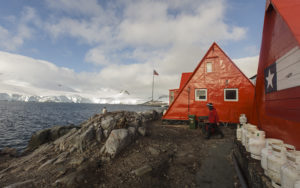 Warm regards to researchers and logistics staff at Yelcho Base (WAP CHL-11), the third of the three platforms managed by INACH in the Antarctic Peninsula. It was inaugurated in 1962, and in 1986 assigned by the Chilean Navy, to the Chilean Antarctic Institute. It had a recess, between the years 1998-2014, and in 2015 was reopened to scientific activities. Currently, the Base can host 22 people and houses several research projects.
Warm regards to researchers and logistics staff at Yelcho Base (WAP CHL-11), the third of the three platforms managed by INACH in the Antarctic Peninsula. It was inaugurated in 1962, and in 1986 assigned by the Chilean Navy, to the Chilean Antarctic Institute. It had a recess, between the years 1998-2014, and in 2015 was reopened to scientific activities. Currently, the Base can host 22 people and houses several research projects.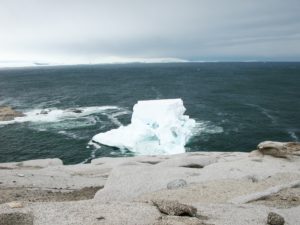 Global warming was leading to an “irreversible” mass melting of the Antarctic ice and purging carbon from the atmosphere was the only solution to slow the process, an Australian climate scientist told Reuters on Wednesday.
Global warming was leading to an “irreversible” mass melting of the Antarctic ice and purging carbon from the atmosphere was the only solution to slow the process, an Australian climate scientist told Reuters on Wednesday.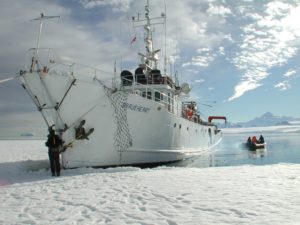 Great CW activity on all bands from onboard R/V Braveheart on the way from Punta Arenas to South Orkneys. The guys at the keyer have done a superb job. Now we remind the chasers that ZL1NA/MM operating from R/V Braveheart is valid for
Great CW activity on all bands from onboard R/V Braveheart on the way from Punta Arenas to South Orkneys. The guys at the keyer have done a superb job. Now we remind the chasers that ZL1NA/MM operating from R/V Braveheart is valid for 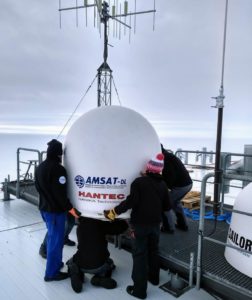 The geostationary satellite QO-100, is an equipment successfully installed at Neumayer III (WAP DEU-Ø8).
The geostationary satellite QO-100, is an equipment successfully installed at Neumayer III (WAP DEU-Ø8).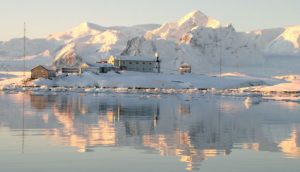 On last February 6, Ukrainian polar scientists did celebrate the birthday of the Antarctic station “Academician Vernadsky”. On February 6, 1996, a blue-yellow flag was raised for the first time over the Faraday Antarctic station, which the UK released to Ukraine. The station which began its new history at that date, is now called Academician Vernadsky.
On last February 6, Ukrainian polar scientists did celebrate the birthday of the Antarctic station “Academician Vernadsky”. On February 6, 1996, a blue-yellow flag was raised for the first time over the Faraday Antarctic station, which the UK released to Ukraine. The station which began its new history at that date, is now called Academician Vernadsky. The discovery of the sixth continent also involved Ukrainians: Ivan Zavadovsky, Lieutenant Captain, Deputy Fabian Gotlib von Bellingshausen, and Anton Omelchenko , a participant in the Robert Antarctic British expedition to the South Pole. Let’s remember these outstanding Ukrainians, as discoverers of Antarctica as well!
The discovery of the sixth continent also involved Ukrainians: Ivan Zavadovsky, Lieutenant Captain, Deputy Fabian Gotlib von Bellingshausen, and Anton Omelchenko , a participant in the Robert Antarctic British expedition to the South Pole. Let’s remember these outstanding Ukrainians, as discoverers of Antarctica as well!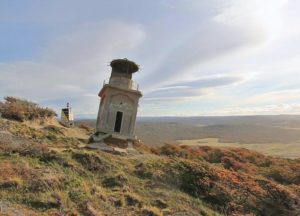 This weekend opens the 12th Edition of the ‘Weekend of the American Lighthouses‘ from Friday 14 to Sunday, February 16, with 86 light houses and beacons of 12 Countries(28 from Argentina, 23 from Brazil, 1 from Costa Rica, 4 from Cuba, 12 from Chile, 3 from Guatemala, 4 from Mexico, 1 from Panama, 4 from Peru, 2 are registered from Puerto Rico, 1 from Uruguay and 3 from Venezuela).
This weekend opens the 12th Edition of the ‘Weekend of the American Lighthouses‘ from Friday 14 to Sunday, February 16, with 86 light houses and beacons of 12 Countries(28 from Argentina, 23 from Brazil, 1 from Costa Rica, 4 from Cuba, 12 from Chile, 3 from Guatemala, 4 from Mexico, 1 from Panama, 4 from Peru, 2 are registered from Puerto Rico, 1 from Uruguay and 3 from Venezuela).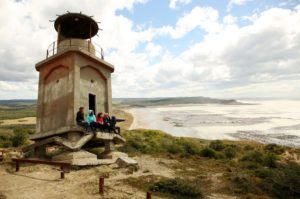
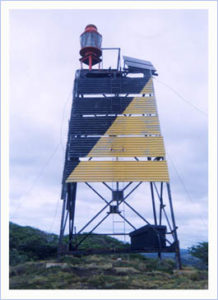
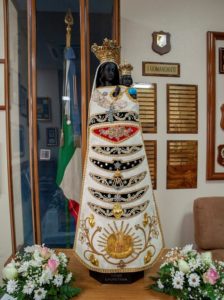
 Two Special Ukrainian event stations EM2ØØANT WAP-305 & EN2ØØANT WAP-306 are on the air to celebrate the 200 years of Antarctic exploration. QSL for both of the calls, via UT1KY
Two Special Ukrainian event stations EM2ØØANT WAP-305 & EN2ØØANT WAP-306 are on the air to celebrate the 200 years of Antarctic exploration. QSL for both of the calls, via UT1KY Great-grandson is Anton Omelchenko, a mechanic, a participant of the 20th (2015-2016) and 24th (2019-2020) Ukrainian Antarctic expeditions in the Antarctica of the Soviet era. Now, with good humor and good humor, it will also be possible to touch on this time of time, where Ukrainians, wintering warriors of the Antarctic expeditions will find themselves.
Great-grandson is Anton Omelchenko, a mechanic, a participant of the 20th (2015-2016) and 24th (2019-2020) Ukrainian Antarctic expeditions in the Antarctica of the Soviet era. Now, with good humor and good humor, it will also be possible to touch on this time of time, where Ukrainians, wintering warriors of the Antarctic expeditions will find themselves.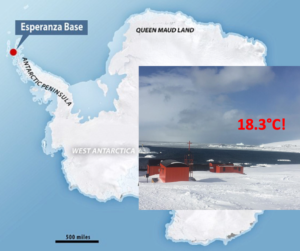 On Febr. 4th 2020 the Argentinean Esperanza Base (WAP ARG-Ø4) in Antarctica, recorded its hottest day on Thursday.18.3°C!
On Febr. 4th 2020 the Argentinean Esperanza Base (WAP ARG-Ø4) in Antarctica, recorded its hottest day on Thursday.18.3°C! February 5th marks the birthday of Argentine Antarctic Base Belgrano II (WAP ARG-Ø6). It was inaugurated on
February 5th marks the birthday of Argentine Antarctic Base Belgrano II (WAP ARG-Ø6). It was inaugurated on  Anadolu Agency has published a bilingual book on Turkey’s Antarctic expedition.
Anadolu Agency has published a bilingual book on Turkey’s Antarctic expedition.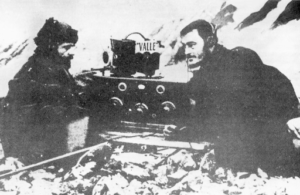 On March 30, 1927, the Navy’s Petty Officer Emilio Baldoni managed to contact Ushuaia, inaugurating the Orcadas Radio Station (LRT), first in Antarctica. Until then the staff remained in communication with the rest of the world for a year until the arrival of their replacements. The Antarctic Naval Command is the organism of the Argentine Navy on which the Orcadas Base (WAP ARG-15) currently depends.
On March 30, 1927, the Navy’s Petty Officer Emilio Baldoni managed to contact Ushuaia, inaugurating the Orcadas Radio Station (LRT), first in Antarctica. Until then the staff remained in communication with the rest of the world for a year until the arrival of their replacements. The Antarctic Naval Command is the organism of the Argentine Navy on which the Orcadas Base (WAP ARG-15) currently depends.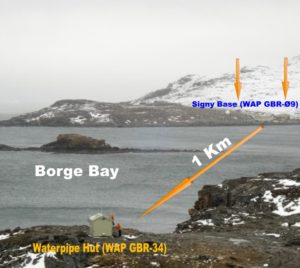 Where exactly are VP8PJ‘s planned to stay when at the South Orkneys DX-pedition?
Where exactly are VP8PJ‘s planned to stay when at the South Orkneys DX-pedition?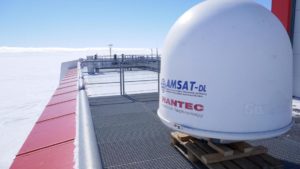 The new Satellite Equipment for QO100 was installed at Neumayer III by a team of radio specialists, as reported on CQ-DL 2/2020, Volker, DL8JDX reports.
The new Satellite Equipment for QO100 was installed at Neumayer III by a team of radio specialists, as reported on CQ-DL 2/2020, Volker, DL8JDX reports.
 China’s fifth station is designed to be a year-round research base which could accommodate 80 people in the summer and 30 people in winter. The new base will provide year-round support for researchers conducting tasks such as observations of land, ocean, atmosphere, ice shelf and biology, establishment of an observation and monitoring network in the Antarctic, and survey of marine environmental protection.
China’s fifth station is designed to be a year-round research base which could accommodate 80 people in the summer and 30 people in winter. The new base will provide year-round support for researchers conducting tasks such as observations of land, ocean, atmosphere, ice shelf and biology, establishment of an observation and monitoring network in the Antarctic, and survey of marine environmental protection. n February 7, 2018, during China 34th Antarctic Expedition, Chinese researchers laid the foundation and started to build its fifth Antarctic Research Station on Inexpressible Island transferring large engineering equipments from China’s research icebreaker Xuelong. It is expected that full construction will be completed in 2022.
n February 7, 2018, during China 34th Antarctic Expedition, Chinese researchers laid the foundation and started to build its fifth Antarctic Research Station on Inexpressible Island transferring large engineering equipments from China’s research icebreaker Xuelong. It is expected that full construction will be completed in 2022. The Artigas Antarctic Scientific Base was visited last Thursday by the Estonian delegation, headed by the country’s President, Kersti Kaljulaid, within the framework of the 200th Anniversary of the Imperial Russian Navy expedition.
The Artigas Antarctic Scientific Base was visited last Thursday by the Estonian delegation, headed by the country’s President, Kersti Kaljulaid, within the framework of the 200th Anniversary of the Imperial Russian Navy expedition.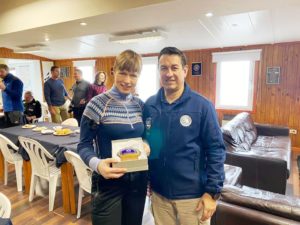 The freezing Antarctic morning, covered by a mist that made almost impossible to see beyond a few meters towards the horizon and fully covering the Collins Glacier did not prevent the President of Estonia, to visit the cold continent and stop at the Uruguayan Antarctic Scientific Base-Artigas (WAP URY-Ø1). After a warm reception by the Uruguayan staff that, in few minutes, made the visitors forget the cold, Uruguayans and Estonians shared a welcome breakfast with typical Uruguayan products.
The freezing Antarctic morning, covered by a mist that made almost impossible to see beyond a few meters towards the horizon and fully covering the Collins Glacier did not prevent the President of Estonia, to visit the cold continent and stop at the Uruguayan Antarctic Scientific Base-Artigas (WAP URY-Ø1). After a warm reception by the Uruguayan staff that, in few minutes, made the visitors forget the cold, Uruguayans and Estonians shared a welcome breakfast with typical Uruguayan products.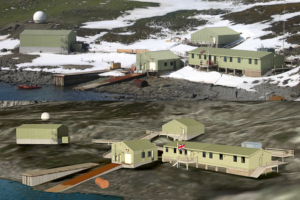 The British Antarctic Survey has a Base; Signy Research Station (WAP GBR-Ø9), established in 1947at 60°43′ Sout, 45° 36′ West, Factory Cove, Borge Bay, Signy Island, South Orkney Islands
The British Antarctic Survey has a Base; Signy Research Station (WAP GBR-Ø9), established in 1947at 60°43′ Sout, 45° 36′ West, Factory Cove, Borge Bay, Signy Island, South Orkney Islands “Marka” Joint-Stock Company has recently made postal products dedicated to the 200th Anniversary of the start of the Bellingshausen and Lazarev expedition to Antarctica.
“Marka” Joint-Stock Company has recently made postal products dedicated to the 200th Anniversary of the start of the Bellingshausen and Lazarev expedition to Antarctica. For example, the “Vostok” and “Mirny” sloops are depicted on the new postage stamps; the fields of the postal block are bordered by the landscape of Antarctica. Models of sailing sloops, complemented by the expedition’s route map, also illustrate unmarked postcards. A souvenir pack includes a postal block and a vignette, as well as a first day envelope with cancellation for Moscow.
For example, the “Vostok” and “Mirny” sloops are depicted on the new postage stamps; the fields of the postal block are bordered by the landscape of Antarctica. Models of sailing sloops, complemented by the expedition’s route map, also illustrate unmarked postcards. A souvenir pack includes a postal block and a vignette, as well as a first day envelope with cancellation for Moscow.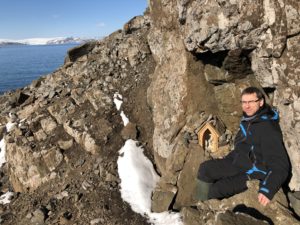 A small Czech chapel has been placed on Febr. 21, 2019 at 62°14,784′ South, 58°58,891′ West in Antarctica during an expedition to the ECO Nelson Base in the South Shetlands on the Nelson Island as already reported on Nov. 22-2019 (
A small Czech chapel has been placed on Febr. 21, 2019 at 62°14,784′ South, 58°58,891′ West in Antarctica during an expedition to the ECO Nelson Base in the South Shetlands on the Nelson Island as already reported on Nov. 22-2019 (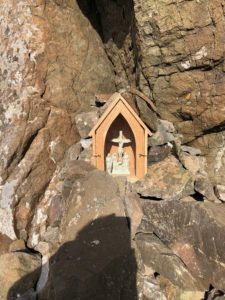 The Chapel -as told WAP by its builder Prof. Ladislav Janíček– was born from an initiative of himself (
The Chapel -as told WAP by its builder Prof. Ladislav Janíček– was born from an initiative of himself (